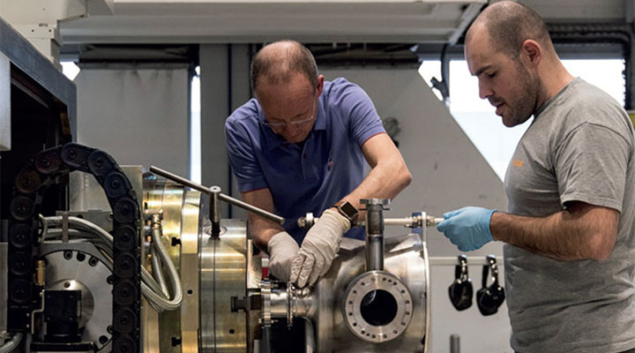

Image credit: F Ulysse/CERN.
As the Large Hadron Collider (LHC) gears up for its 2017 restart, teams in the background at CERN and around the world are making rapid progress towards a major LHC upgrade due to be operational from 2025. A significant milestone towards the High-Luminosity LHC (HL-LHC), which will boost the number of proton–proton collisions, was passed in late February with the first tests of a new accelerator structure called a crab cavity.
Increasing the luminosity of the LHC, which is a measure of its collision rate, requires new magnets located on either side of the LHC detectors that squeeze the incoming proton beams into tighter bunches and force them to cross one another at a steeper angle. These upgraded inner-triplet quadrupoles for the HL-LHC, prototypes of which have recently been completed at CERN and in the US, have larger apertures than the present LHC magnets and are based on more advanced niobium-tin superconducting technology (CERN Courier March 2017 p23).
Crab cavities are essential to fully exploit the inner-triplet upgrade, since they allow the crossing angle of the proton beams to be compensated so as to maximise their overlap at the collision points. Constructed from high-purity niobium sheets, the HL-LHC crab cavities will operate at 2 K to reach their nominal performance. Unlike the accelerating RF cavities currently used at the LHC, which accelerate protons in their direction of motion, the crab cavities give the bunches a time-dependent transverse kick in the plane perpendicular to their motion to improve “luminosity levelling”.
So far, two superconducting crab cavities have been manufactured at CERN and RF tests at 2 K performed in a superfluid helium bath. The first cavity tests demonstrated a maximum transverse kick voltage exceeding 5 MV, surpassing the nominal operational voltage of 3.4 MV. This kick voltage corresponds to extremely high electric and magnetic fields on the cavity surfaces: 57 MV/m and 104 mT, respectively. By the end of 2017, the two crab cavities will have been inserted into a specially designed cryomodule that will be installed in the Super Proton Synchrotron (SPS) to undergo validation tests with proton beams. This will be the first time that a crab cavity has ever been used for manipulating proton beams, and a total of 16 cavities (eight near ATLAS and eight near CMS) will be required for the HL-LHC project.





